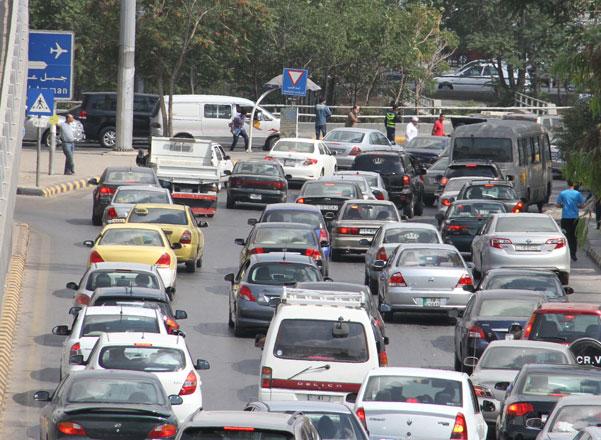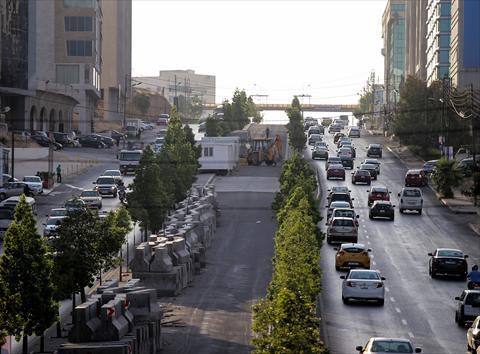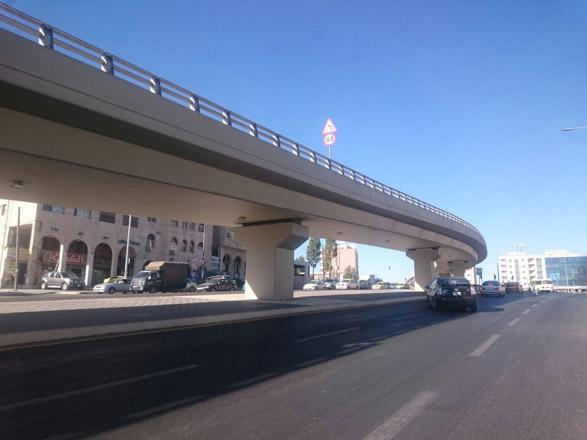You are here
Not an easy job, but Amman’s traffic headache curable — experts
By Mohammed Kloub - Jul 28,2016 - Last updated at Jul 28,2016

Traffic in Amman on Wednesday. Awareness and better law enforcement are likely to help ease congestions in the capital, experts say (Photo by Hassan Tamimi)
AMMAN — Like many large cities and capitals, Amman has a heavy traffic problem and the gridlock on the city’s streets is getting worse, according to transportation experts, who offered some ideas to ease the congestions.
Amman’s traffic troubles can be attributed to two key factors, according to Ayman Smadi, executive director of the transport and traffic department at the Greater Amman Municipality (GAM): uncontrolled growth and a dependence on private vehicles.
According to Smadi, the population of Amman has nearly doubled every decade over the last 30 years. Even with proper planning, that kind of rapid growth is too difficult for infrastructure to keep up with.
While Amman is not unique compared to other large cities in facing huge growth, it is unique in its attitude to navigating it.
“It has become almost a social stigma to use public transport,” Smadi said. “No city with such a big population relies so exclusively on cars like Amman.”
Residents’ dependence on private cars is “a result of decades of investments in road infrastructure and a lack of growth in public transport”, according to Hazem Zureiqat, transportation consultant at Engicon, a consulting engineering firm in Amman.
Public transport, typically seen as a necessity for growing cities worldwide and a solution to congested roads, has remained disjointed in Amman, which was planned on an “ad hoc basis” and lacks significant government subsidies, Zureiqat said.
But solutions are in the works, and plans are being analysed for the long-term as the city’s population continues to grow.
Bus Rapid Transit
The Bus Rapid Transit (BRT) project, expected to launch in 2018, is estimated to cost JD180 million, broken down into two parts: JD120 million for the infrastructure and JD60 million for operational costs, GAM officials have stated.
The plan involves operating modern buses capable of carrying approximately 120 passengers on their own designated lanes along Amman’s busiest streets.
It is expected to help reduce traffic by providing plenty of things current bus systems in the city lack, like decent vehicles, smart payment, air conditioning and a commitment to regular operating schedules.
“The key parameter in the end is travel time,” Smadi said, in regards to whether or not citizens would leave their private cars to use the new buses.
“If you drive your car for 45 minutes in traffic to get to work, and it takes 15 minutes with an alternative, people will eventually switch. But we haven’t provided that alternative yet.”
The infrastructure costs will go towards painting roads, creating bus stations, and building bus terminals. The operational side will fund the new vehicles themselves, along with the information systems required for such a programme.
“[BRT] will showcase what it means to have modern, reliable public transport in Amman and will hopefully set the stage for further improvements and projects,” Zureiqat said.
A rail system for long-term solutions
As many large cities like London and New York have realised, a longer-term solution is eventually necessary to transport large populations. That solution is often a light rail or metro system, typically underground.
“It’s a natural progression after something like BRT,” Smadi said. “As the population continues to grow, it will be a necessity for Amman to have a rail system.”
But would an underground rail system be feasible in Jordan’s capital?
Early GAM analysis for such a project estimates it would cost JD100 million per kilometre, which includes both tunnelling underground and laying down the actual rails.
A tram would be cheaper, according to Smadi, but would face more logistical problems with sloping roads and would not provide as high a capacity.
The key for Amman, before preparing any sort of infrastructure, is balancing demand with capacity and cost for citizens, Smadi said.
A high level of subsidy is needed to bring a light rail or metro to the city, but commercial development around such projects is attractive for the private sector, so the benefits go beyond simply reducing traffic.
“Further work needs to be done to assess such a project’s feasibility,” according to Zureiqat. “What I am certain about is that Amman needs a high-capacity, rapid transit system — be it a metro or light rail, underground or at street level — to serve future demand. The current system and mode of operation are not sustainable.”
Managing traffic in the meantime
While public transportation projects like BRT and a rail system are being developed, there are still ways to reduce traffic jams and dangerous driving.
“The key to traffic safety is human behaviour,” Smadi said. “We have congestion, but it’s not different from other big cities.”
According to Smadi, one solution that can be worked on today is an education system for young people to teach them the essentials of safe driving, like reducing distractions and not speeding.
For Zureiqat, there is no lack of short-term solutions that can be developed as Amman works towards better public transportation.
“With the right measures and technologies and with little investment, we can manage our road network better and make it more efficient,” he said. “We could add traffic lights at certain locations to regulate the flow of cars, we could provide better real-time information about congestion to drivers, and we could better enforce traffic laws to have less disruption to flow and fewer accidents.”
Related Articles
AMMAN — A study conducted by the Chinese Railway Engineering Corporation (CREM) for the Greater Amman Municipality (GAM) has confirmed that
AMMAN — The Greater Amman Municipality (GAM) will start working on the third stage of the Bus Rapid Transit (BRT) project in early July, add
AMMAN — The Bus Rapid Transit (BRT) Project Director Riyad Kharabsheh said that the Greater Amman Municipality (GAM) will complete the const
















